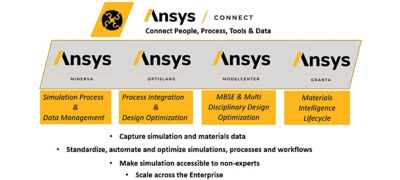-
United States -
United Kingdom -
India -
France -
Deutschland -
Italia -
日本 -
대한민국 -
中国 -
台灣
-
Ansys는 학생들에게 시뮬레이션 엔지니어링 소프트웨어를 무료로 제공함으로써 오늘날의 학생들의 성장을 지속적으로 지원하고 있습니다.
-
Ansys는 학생들에게 시뮬레이션 엔지니어링 소프트웨어를 무료로 제공함으로써 오늘날의 학생들의 성장을 지속적으로 지원하고 있습니다.
-
Ansys는 학생들에게 시뮬레이션 엔지니어링 소프트웨어를 무료로 제공함으로써 오늘날의 학생들의 성장을 지속적으로 지원하고 있습니다.
ANSYS BLOG
February 14, 2024
Maximize Your Digital Thread and PLM System with an Open SPDM Solution
If you read our previous blog about simulation process and data management (SPDM) and product life cycle management (PLM) systems, then you already know why you need an SPDM solution in addition to your PLM system. If you missed it, the short version is that SPDM and PLM are not the same thing.
Each solution is built for different data. PLM was designed to manage computer-aided design (CAD) data, while SPDM was built to manage simulation data. Nevertheless, companies are often reluctant to embrace an SPDM solution and assume their existing PLM systems can handle the job. However, PLM systems cannot manage simulation data as efficiently as SPDM solutions — and, more importantly, they don’t have to.
SPDM enables teams to manage simulation, data, workflows, and resources throughout their organization from one central database. Yet, not all SPDM solutions are created equal. A key ingredient of your SPDM solution should be its interoperability with other systems and tools. Some vendors’ SPDM systems can only manage simulation data created by their own tools, but an open SPDM system can effectively manage data created by any simulation tool.
The Ansys Minerva SPDM solution is built upon an open ecosystem and works seamlessly with Ansys software, third-party tools, existing PLM and CAD systems, and other enterprise applications like enterprise resource planning (ERP) systems. Selecting an open SPDM solution not only enables you to maintain your existing workflows, but also supports a digital thread. Let’s explore the benefits of an open ecosystem versus a closed ecosystem.
Understand the Basics of an Open Ecosystem
One of the easiest ways to understand the differences between an open ecosystem and a closed ecosystem is to consider something that most of us are very familiar with: cellphones. Whether you have an Android phone or an iPhone, you can recognize the nuances of each. An Android device is part of an open ecosystem, which means that you can easily add applications and plug-ins (e.g., music, games, health, etc.) irrespective of their origin or vendor. On the other hand, Apple devices are part of the iPhone operating system (iOS) and perform within a closed ecosystem. In this environment, it’s not as easy to add outside modules, and provided options are limited to Apple-based apps like iTunes for music, for example.
With this understanding in mind, let’s consider SPDM solutions again. Choosing an SPDM solution like Minerva gives the user the flexibility to work with any other system or tool because it is part of an open ecosystem. In contrast, selecting an SPDM tool that is part of a closed ecosystem would limit the user and not integrate seamlessly with their existing systems.
While an open ecosystem provides more choices and flexibility to bring in outside apps or modules there must be a drawback, right? An open ecosystem cannot provide the single, uniform user experience that a closed system offers, but this is a trade-off for the creative and technical freedom that an open environment provides.

Ansys Connect products help organizations create a complete digital thread.
Support a Digital Thread
As technology advances and more companies embrace digital transformation, interest has increased in digital threads. Put simply, a digital thread is like a communication line woven throughout all the tools in your workflow. This interconnected thread enables data to flow more easily to and from various tools while increasing traceability, collaboration, and productivity across teams.
Minerva has a vendor-neutral architecture and blends easily with existing systems. Further, it is part of the Ansys Connect family of products, which includes Ansys Granta MI Enterprise materials management, Ansys optiSLang process integration and design optimization, and Ansys ModelCenter model-based systems engineering (MBSE) software. Naturally, Connect products seamlessly integrate with each other, but, by way of Minerva, each product also easily integrates with existing PLM systems and other frameworks. For example, Minerva’s interoperability with Granta MI Enterprise and other tools ensures that digital threads are complete with everything from CAD data to material intelligence. This means that Minerva supports a digital thread of simulation, material, PLM, and other data from a wide range of tools both inside and outside of Ansys.
By selecting an open SPDM solution, you can enhance your PLM system and increase operational efficiency without disrupting your existing workflows. There are software companies that develop PLM products with this in mind, building systems that integrate with Minerva and other third-party SPDM tools.

By way of Ansys Minerva, Connect products easily integrate with existing product life cycle management (PLM) workflows and support a complete digital thread.
Discover Ways to Connect
Digital transformation is challenging industries to adopt new workflows, systems, and technologies. An effective, open SPDM solution can blend easily with existing systems, enhance PLM, optimize operations, and support a complete digital thread.
To learn more, discover how to create a digital thread with Minerva and other Connect products. To explore how Minerva can help your organization, request a free assessment.













